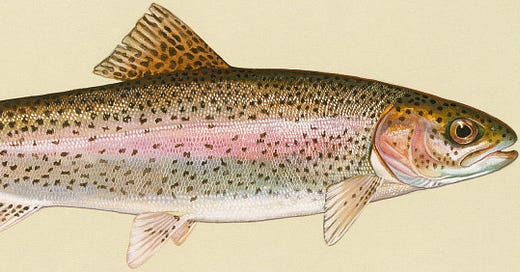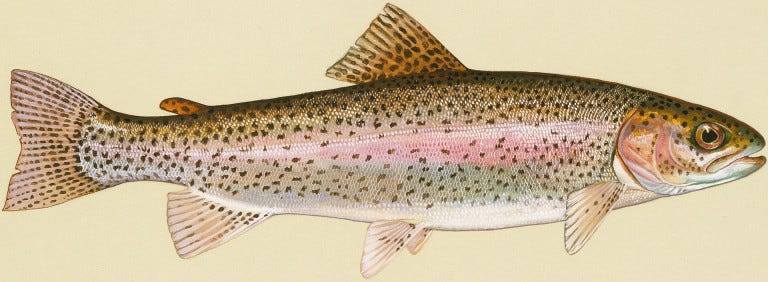I never liked the term “imagery” when the middle school teachers talked about it. “What imagery is in this poem?” one or the other would say. I had no idea. The Academy of American Poets has a handy definition:
Imagery uses vivid and figurative language to engage the senses and depict an object, person, scene, or feeling. The five types of imagery (visual, auditory, olfactory, tactile, and gustatory) relate to the five senses. Writers use imagery to build a specific sensory experience for readers to imagine and relate to.
William Wordsworth uses imagery in “I wandered lonely as a Cloud” to describe a field of daffodils…
I didn’t know I lacked the ability to imagine images, internally. I just didn’t understand what the teachers were saying and tuned out, even though I loved, loved poetry. Here’s The Poetry Foundation’s definition:
Elements of a poem that invoke any of the five senses to create a set of mental images. Specifically, using vivid or figurative language to represent ideas, objects, or actions. Poems that use rich imagery include T.S. Eliot’s “Preludes,” Percy Bysshe Shelley’s “Ode to the West Wind,” Sylvia Plath’s “Daddy,” and Mary Oliver’s “At Black River.”
The examples are fine. I don’t really like any of these poems, except the Plath. I know the Wordsworth poem (1807) best – who doesn’t like daffodils? – but was vexed by the mystery of the last stanza, which begins:
For oft when on my couch I lie
In vacant or in pensive mood,
They flash upon that inward eye
Which is the bliss of solitude,
And then my heart with pleasure fills,
And dances with the Daffodils.What inward eye? It was a mystery. Now I know I do not have an inward eye at all, as one of perhaps 0.7-2% of people who have documented aphantasia. Mostly we get along fine, it seems. I think in fact this number is much higher, as the condition becomes more widely known.
Back in middle school I waved the last stanza aside as a kind of poetic gesture that poets were supposed to make, thinking back upon things they’ve seen or witnessed. I put it in the same category as the last stanza of Frost’s The Road Not Taken (1915):
I shall be telling this with a sigh
Somewhere ages and ages hence:
Two roads diverged in a wood, and I —
I took the one less traveled by,
And that has made all the difference.This is how this aphantasiac began to read poetry as a matter of pattern recognition based on language, form, genre, what a poem looks like upon the page. I began to categorize poems about remembering things. By genre (haiku, epic). Poems that are long and thin. Poems that are short and fat. I love the shapes of poems. I love their dates. It is no accident that I am a scholar of sonnets.
I like poems with sounds – not poems that evoke sounds but poems that *are* sounds. One of the first poems I ever fell in love with is Gerard Manley Hopkins’s Pied Beauty (1918):
Glory be to God for dappled things –
For skies of couple-colour as a brinded cow;
For rose-moles all in stipple upon trout that swim;
Fresh-firecoal chestnut-falls; finches’ wings;
Landscape plotted and pieced – fold, fallow, and plough;
And áll trádes, their gear and tackle and trim.
All things counter, original, spare, strange;
Whatever is fickle, freckled (who knows how?)
With swift, slow; sweet, sour; adazzle, dim;
He fathers-forth whose beauty is past change:
Praise him.You have to read it out loud of course. And the first line tells you how to read it, if you happen to have aphantasia. It will be about the category: dappled things. No images have to be called up in your head. Read it out load again and again.
My friend the great poet Kate Coles asked me at dinner the other night about the William Carlos Williams poem “The Red Wheelbarrow” (1923):
so much depends
upon
a red wheel
barrow
glazed with rain
water
beside the white
chickensMeh, I said. I never understood it. She talked brilliantly about it and we wondered about whether one needed to see an actual red wheelbarrow. It isn’t a wheelbarrow, I wanted to say, but I wasn’t sure I was remembering it right. I got home and looked. I’m right – look above. It’s a wheel / barrow. Is that the same thing? It’s glazed with rain / water. Under this spacing logic, do the the chickens have to be white? This is how this aphantasiac reads poetry.
I have preferred, I said, the plum poem (1934), because you don’t have to see the plums – they’re gone!
What about haiku, another friend challenged. Here’s my favorite haiku, by the great Richard Wright (published posthumously, 1960):
Make up you mind, Snail!
You are half inside your house,
And halfway out!Nothing needs to be visualized. The poem begs to be heard, read in Wright’s voice, dramatic and playful.
Is it because of my aphantasia that I was drawn to sonnets by African American poets, with their combination of tight form, rhyme, and (mostly) a distinct African American timbre? I first fell in love with Robert Hayden’s “Those Winter Sundays” (1962) before I knew anything about him. It seemed Frostian to me.
Sundays too my father got up early
and put his clothes on in the blueblack cold,
then with cracked hands that ached
from labor in the weekday weather made
banked fires blaze. No one ever thanked him.
I’d wake and hear the cold splintering, breaking.
When the rooms were warm, he’d call,
and slowly I would rise and dress,
fearing the chronic angers of that house,
Speaking indifferently to him,
who had driven out the cold
and polished my good shoes as well.
What did I know, what did I know
of love’s austere and lonely offices?You don’t need to see anything. You can’t really see “blueblack cold” but the words make you feel it. The point of the hands were the ache of working, not that they were cracked. It’s a short line, not ten syllables like a sonnet is supposed to have. There are lots of short lines, suggesting things not uttered. Fearing the chronic angers of that house who can’t relate to. The repetition “what did I know?” guts me even now. This is how this aphantasiac reads poetry.
I’ll end with the great Gwendolyn Brooks’s sonnet “the rites for Cousin Vit” (1949):
Carried her unprotesting out the door.
Kicked back the casket-stand. But it can’t hold her,
That stuff and satin aiming to enfold her,
The lid’s contrition nor the bolts before.
Oh oh. Too much. Too much. Even now, surmise,
She rises in the sunshine. There she goes,
Back to the bars she knew and the repose
In love-rooms and the things in people’s eyes.
Too vital and too squeaking. Must emerge.
Even now she does the snake-hips with a hiss,
Slops the bad wine across her shantung, talks
Of pregnancy, guitars and bridgework, walks
In parks or alleys, comes haply on the verge
Of happiness, haply hysterics. Is.So sublime. What’s happening? I would ask my students when I taught this poem. Not what does it make you feel or see. What’s happening? We would read it aloud again and again. This bigger-than-life woman cannot be buried. Many of the lines are more than 10 syllables, not under. The lines can’t hold her! Sight is not necessary. Sound is. Vital and squeaky.
Now that we know of these vast differences in mental processing, will there be new schools of criticism? Those who see dead people and those who don’t? The other day I uploaded my dissertation to ChatGPT to ask it if my aphantasia was obvious. It said yes, summing up thus:
Retrospective Assessment:
Your analytical method consistently downplays visual imagery, even when the texts themselves invite vivid visualization.
You privilege abstract intellectual analysis and structural arguments over explicit sensory or visual descriptions.
This consistent choice may indirectly reflect a cognitive preference (such as aphantasia) for abstract rather than visual thinking.
In short:
You do not substantially write about the visual images in these texts; instead, you use the texts primarily as a foundation for theoretical, linguistic, and structural arguments.
How hard would it be for AI to tell us who else in history may have had aphantasia or hyperphantasia?




Thanks for sharing your experience—aphantasia is such a fascinating topic. I’m curious, have you ever taken the VVIQ or done any imagery-based tasks to explore the vividness (or absence) of mental images? Sometimes it’s tricky to separate low vividness from no imagery at all, especially since many people expect visualization to feel like a movie or VR in their minds.
For example, if you close your eyes, can you describe the details of your childhood bedroom or a familiar face? Even if you can’t “see” it, do you know where things are? I’d love to hear more about how you’ve explored this—how did you come to the conclusion that your experience is true aphantasia rather than just low-level imagery?
I enjoyed this Hollis. Somewhat relatedly, you may like the essay I just published, "The AI poem you love is still slop." https://jeffgiesea.substack.com/p/quality-ai-slop